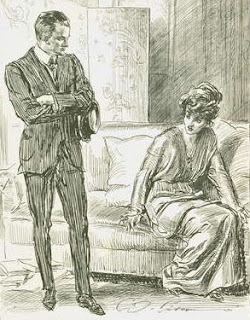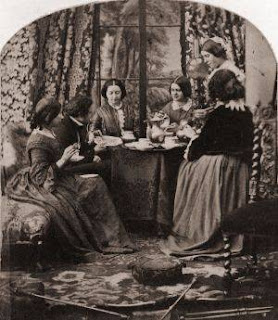What were the Victorians drinking?
While visiting Boston, Charles Dickens said “the bar is a large room with a stone floor, and there people stand and smoke, and lounge about, all the evening dropping in and out as the humor takes them.
There too the stranger is initiated into the mysteries of Gin-sling, Cocktail, Sangaree, Mint Julep, Sherry-cobbler, Timber Doodle, and other rare drinks.”
From Harry Johnson’s Bartenders’ Manual, 1882.
Whiskey Cocktail
¾ glass of shaved ice
1 or 2 dashes Curacoa
2 or 3 dashed of gum syrup*
1 jigger whiskey
1 ½ or 2 dashes of bitters
“Stir and strain in a cocktail glass, adding cherry or olive, squeezing lemon peel on top and serve. This drink is without a doubt one of the most popular American drinks in existence.”
Particularly popular among Parisian artists and writers, Absinthe is an anise flavored spirit derived from wormwood, anise, fennel, and other medicinal and culinary herbs. Commonly referred to as the green fairy due to its color, it was a favorite with Toulouse-Lautrec, who often carried some in his hollowed-out cane
 Mint Julep
Mint Julep
Described as a dram of spirituous liquor steeped with mint and taken by Virginians of a morning.
Bourbon is the preferred liquor, while silver cups are the traditional way to serve it; being careful to hold the cup either from the bottom or top rim, so the fingers do not disturb the frost that develops on the outside.
Henry Clay, a famous Kentucky statesman, said a mint julep is a ceremony. It is a rite that “must not be entrusted to a novice, a statistician, nor a Yankee."ecial. One of them is the Prince of Wales Cocktail. According to the history behind this cocktail, it is believed to be invented by Edward Albert sometime in the 1860s. He was the son of Queen Victoria. At that time Edward Albert was the Prince of Wales so that is why this cocktail is named as Prince of Wales Cocktail. This cocktail is not only famous in United Kingdom but in many other European Countries along with U.S and Canada. It can be prepared at home in a very short span of time. Just make sure you have all the ingredients and requirements available to prepare this cocktail. The below given steps can be followed for making it if it is your first time. Preparation Time: 10 minutes Serving Size: 01 Utensils required: Champagne flute or Cocktail Glass, Shaker and Stirrer Ingredients: - Cognac (¾ oz) - Champagne (4 oz) - DOM Benedictine (¼ oz) - Angostura Bitter (2 - 3 dashes) - Sugar (1 teaspoon) - Crushed Ice
Read more at: Step by Step How to Make a Prince of Wales Cocktail
http://www.stepbystep.com/how-to-make-a-prince-of-wales-cocktail-9555/There are some cocktails for whose names are more than enough to make them real special. One of them is the Prince of Wales Cocktail. According to the history behind this cocktail, it is believed to be invented by Edward Albert sometime in the 1860s. He was the son of Queen Victoria. At that time Edward Albert was the Prince of Wales so that is why this cocktail is named as Prince of Wales Cocktail. This cocktail is not only famous in United Kingdom but in many other European Countries along with U.S and Canada. It can be prepared at home in a very short span of time. Just make sure you have all the ingredients and requirements available to prepare this cocktail. The below given steps can be followed for making it if it is your first time. Preparation Time: 10 minutes Serving Size: 01 Utensils required: Champagne flute or Cocktail Glass, Shaker and Stirrer Ingredients: - Cognac (¾ oz) - Champagne (4 oz) - DOM Benedictine (¼ oz) - Angostura Bitter (2 - 3 dashes) - Sugar (1 teaspoon) - Crushed Ice
Read more at: Step by Step How to Make a Prince of Wales Cocktail
http://www.stepbystep.com/how-to-make-a-prince-of-wales-cocktail-9555/
There are some cocktails for whose names are more than enough to make them real special. One of them is the Prince of Wales Cocktail. According to the history behind this cocktail, it is believed to be invented by Edward Albert sometime in the 1860s. He was the son of Queen Victoria. At that time Edward Albert was the Prince of Wales so that is why this cocktail is named as Prince of Wales Cocktail. This cocktail is not only famous in United Kingdom but in many other European Countries along with U.S and Canada. It can be prepared at home in a very short span of time. Just make sure you have all the ingredients and requirements available to prepare this cocktail. The below given steps can be followed for making it if it is your first time. Preparation Time: 10 minutes Serving Size: 01 Utensils required: Champagne flute or Cocktail Glass, Shaker and Stirrer Ingredients: - Cognac (¾ oz) - Champagne (4 oz) - DOM Benedictine (¼ oz) - Angostura Bitter (2 - 3 dashes) - Sugar (1 teaspoon) - Crushed Ice
Read more at: Step by Step How to Make a Prince of Wales Cocktail http://www.stepbystep.com/how-to-make-a-prince-of-wales-cocktail-955
 Queen Victoria's son, Edward Albert loved the partying lifestyle and that included plenty of champagne. The Prince of Wales Cocktail, is named after him
Queen Victoria's son, Edward Albert loved the partying lifestyle and that included plenty of champagne. The Prince of Wales Cocktail, is named after him.
1 1/2 ounce rye whiskey
1/4 teaspoon maraschino
1 dash Angostura bitters
1 teaspoon sugar
1 square of pineapple
1 ounce chilled champagne
And for teetotalers there was always, Perrier.
Once a source of refreshment for Roman soldiers, this delightful naturally carbonated water spurts from limestone hills near Nimes, France. In 1898 Doctor Louis Perrier became sole owner of the domain called the "Vergeze Company for mineral water, drinks and health products". He discovered its' therapeutic possibilities and perfected bottling techniques.
 Lenore stood on the underground train as it rattled it's way to Paddington station. It was one of those dreary London mornings shrouded in fog when all the men in her cabin displayed not a shred of chivalry and continued to read their newspapers rather than offer her a seat.
Lenore stood on the underground train as it rattled it's way to Paddington station. It was one of those dreary London mornings shrouded in fog when all the men in her cabin displayed not a shred of chivalry and continued to read their newspapers rather than offer her a seat.  Shrugging away the insult, she took the opportunity to peruse their papers and to her delight came upon the latest edition of the Illustrated London News. There on its cover was the royal family gathered round their live Christmas tree. She had heard that several years before the German Prince Albert had introduced the tradition to his wife, Queen Victoria, and she had embraced the custom each year at Windsor Castle. If only Archibald would agree, Lenore was certain it would be a glorious sight to behold in her bay window.
Shrugging away the insult, she took the opportunity to peruse their papers and to her delight came upon the latest edition of the Illustrated London News. There on its cover was the royal family gathered round their live Christmas tree. She had heard that several years before the German Prince Albert had introduced the tradition to his wife, Queen Victoria, and she had embraced the custom each year at Windsor Castle. If only Archibald would agree, Lenore was certain it would be a glorious sight to behold in her bay window.














































